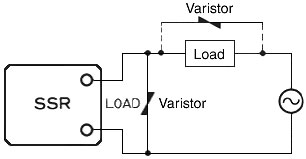What should be done about surge-absorbing circuits for AC-load Solid-state Relays?
Measures against AC Switching Solid-state Relay Output Noise Surges
1. The Solid-state Relay has a built-in snubber circuit to smooth out a sudden rise in voltage. If there is a large voltage surge in the output-side AC power supply, the snubber circuit will not be sufficient to suppress the surge, and overvoltage will damage the output elements.
2. The following models have a built-in surge-absorbing varistor:
G3NA, G3S, G3PA, G3PB, G3NE, G3J, G3NH, G9H, G3DZ (some models), G3RZ, G3FM
3. Be sure to take measures against surge when switching an inductive load with an Solid-state Relay that does not have a built-in surge-absorbing element. (Refer to the following figure.)
Note: A separate varistor with a surge resistance higher than the built-in varistor must be mounted externally if influence is possible from noise that is not completely absorbed by the built-in varistor (surge resistance: 700 to 1000 A).

Select a surge-absorbing element that meets the conditions in the following table.
| Voltage | Varistor voltage | Surge resistance |
| 100 to 120VAC | 240 to 270 V | 1,000 A min. |
| 200 to 240VAC | 440 to 470 V | |
| 380 to 480VAC | 820 to 1,000 V |